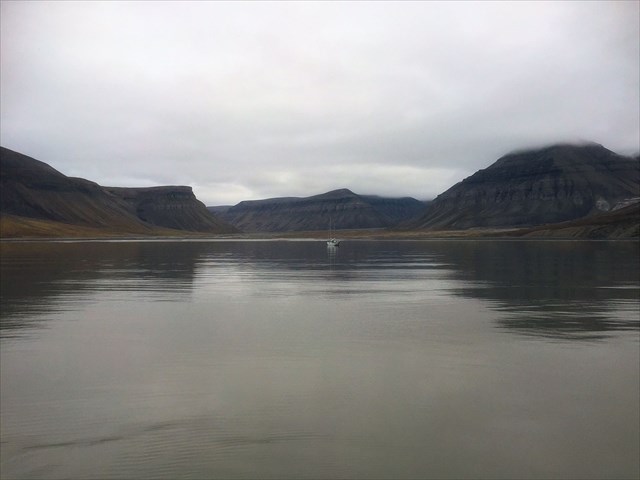This earthcache is by the shore of Skansbukta which is a bay in Billefjord. It can be reached by boat from Longyearbyen, including on some tours to Pyramiden. We saw three polar bears near the glacier further along the fjord.

In order to log this earthcache, please email me answers to the following questions:
1. There is a very obvious boundary between the Gipshuken and carbonate formations. Estimate the height above sea level at which the boundary occurs and the angle of the carbonate cliff to horizontal. Speculate as to what has caused the boundary with the Gipshuken formation to be so obvious.
2. Give a possible explanation of why anhydrite and not gypsum was deposited at Skansbukta.
3. What is unusual about the water solubility of gypsum?
It would also be nice to see a photo of you at Skansbukta, but this is optional.
Spitsbergen is an island where, because of the lack of vegetation, the geology of the landscape is very visible. The oldest minerals on the island were deposited when it was close to the South Pole over 600 million years ago. Since that time continental drift has taken it northwards, and during the Carboniferous period (about 360 to 300 million years ago) it was a wet, tropical land with swamps that were to create the coal which later became the island’s principal mining industry. In the following Permian period (about 300 to 250 million years ago), the climate was drier and, in shallow marine seas, evaporation concentrated minerals and deposited them as beds of gypsum, anhydrite and dolomite.
Gypsum and anhydrite are both forms of calcium sulphate. Gypsum is the dihydrate CaSO4.2H2O form which means the calcium sulphate has crystallised with two molecules of water in the structure for every calcium cation (positively charged ion) and sulphate anion (negatively charged ion). Anhydrite is the anhydrous form of calcium sulphate, which means that there is no water in the crystal structure. Gypsum can be turned into anhydrite by heating it to 200oC which drives off the water and anhydrite can turn into gypsum by leaving it in a moist atmosphere. Gypsum is used widely in plasterboard and cement and has been commercially mined around the world for many years. Although anhydrite is also mined for use in some cements, agriculture and formally as a source of sulphur for sulphuric acid production, it is generally less attractive commercially than gypsum.
At Skansbukta, it is principally anhydrite that was deposited, in a horizontal seam through the mountain Skansen, although close to the surface this has absorbed water to make gypsum. The anhydrite is in the Gipshuken Formation at the bottom of the mountain. Above that there are striking formations of mainly dolomite and hardened calcium carbonate.
At the beginning of the 20th century the deposit was discovered which created much interest as it was believed that the whole deposit was gypsum. A mine was opened in 1918 by Dalen Portland Cementfabrikk but it closed within a year, partially due to the discovery that the deposit was largely anhydrite. In the 1930s Kjøde reopened the mine but the venture only lasted a few years.
The entrance to the mine can still be seen along with various cabins and mining equipment. The local government wants these remnants to remain as they are until they decay naturally, so please do not increase their slow decay by damaging them.
You can find useful information about anhydrite here.